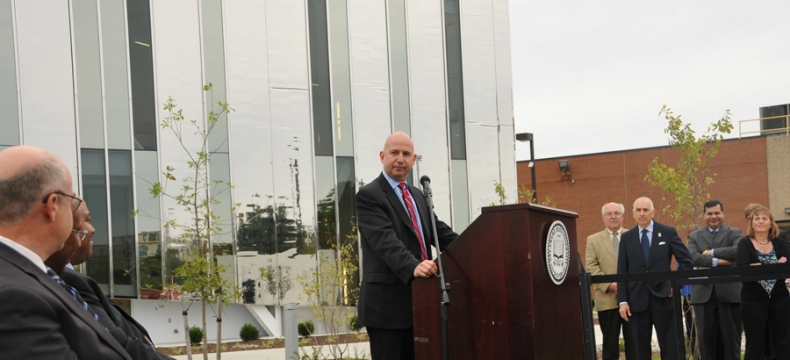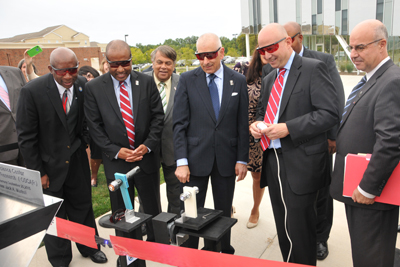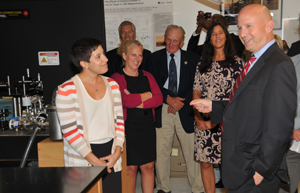
DSU, Gov. Markell Formally Dedicate OSCAR Building
Gov. Jack Markell joined DSU administrators, board members and scientists on Sept. 25 to formally dedicate the Delaware Institute for Science and Technology’s Optical Science Center for Applied Research (OSCAR) Building on campus.
|
|
The $18 million OSCAR Building houses the University’s robust optics research program, which investigates a diverse range of novel applications of laser technologies.
The research facility was made possible through the support of Gov. Markell, who persuaded the General Assembly to agree to contribute $10 million in state funding toward the building’s construction.
“The state’s investment in this OSCAR Building will help to build on the years of progress made by the students and faculty of DSU’s Optics Program,” Gov. Markell said. “With this unique infrastructure in place, we are hopeful that OSCAR researchers will be better able to find solutions to some of the scientific challenges facing us today.”
Much of the OSCAR work involves research that seeks to improve upon the use of current laser technologies and create new ones that can speed up the early diagnosis of many diseases, upgrade the ability of military soldiers in the field to detect dangerous threats, provide analysis of the Mars environment to understand its potential to sustain life, and be applied in many other areas.
The construction of the OSCAR Building began in November 2013 and was completed on June 1 of this year. The 28,000-square-foot, three-story building provides DSU Optics scientists and faculty with a facility specifically designed for optics research. As such, the laboratory side of the building sits atop a deep concrete foundation that eliminates the ground vibrations that can disrupt the accurate use of laser technology.
The building’s completion highlights the 20-year work of Dr. Noureddine Melikechi, director of OSCAR, who founded DSU’s involvement in optics research in 1998 with the Center for Applied Optics Research. Through the diligent research of Dr. Melikechi and other optics scientists at DSU over the years, the program has attracted tens of millions of dollars in research grants from sources such as the National Science Foundation and NASA.
In reflecting on the tremendous progress that DSU has made in the sciences and technologies of light, Dr. Melikechi said he is “hopeful and humbled” by the possibilities that the Optical Science Center for Applied Research Building will present.
|
|
“This spectacular building is a convergence point where interdisciplinary science, technology, education and innovation will flourish together for the benefit of all. OSCAR is about light,” Dr. Melikechi said. “Light is life. Light is in our past and present and I have no doubt that its impact on our lives will be even more profound in the future.”
DSU President Harry L. Williams said that visionary thinking and pursuits are what transformed optics into the prolific research program it has become at DSU.
“Just as we have witnessed the development of optics research here over the last 20 years, DSU has other science disciplines such as neuroscience, chemistry and others that appear to be on a similar trajectory,” Dr. Williams said. “The mentality of limitless possibilities is a mindset that is being adopted by more and more of our faculty and portends an exciting future for this institution.”
Among some of the research projects currently underway in the OSCAR Building:
- Dr. Noureddine Melikechi’s research focuses on developing sensitive optical techniques for the early detection of cancer, including prostate cancer and epithelial cancer.
- Dr. Yuri Markushin is working on the use of nanoparticles that can be used to tag specific proteins and help detect tumors that are smaller than one centimeter.
- The laboratory of Dr. Amir Khan is working with lasers and optics designs to develop a greenhouse gas sensor for methane and nitrous oxide.
- Dr. Tripathi and her team are developing next generation optical imaging systems such as LADAR – a remote sensing technology that measures distance and properties of an object by illuminating it with a laser and analyzing the reflected light.
- Dr. Deborah Santamore is working to resolve experimental problems that nanodiamond-based sensors currently face, and therefore help advance the development of ultra-high resolution imaging magnetometry.
- A team of researchers under Dr. Gour S. Pati is studying the interaction of light with matter in atomic vapor to explore a wide variety of atomic phenomena including slow and superluminal high propagation for sensing, detection and precision measurement applications.
- Dr. Sokratis Makrogiannis and his team are working on the development of mathematical techniques and computer algorithms for tissue identification and computer-aided diagnosis using MRI and CT imaging data.
- Dr. Qi Lu and her team are using an atomic force microscope to research how gold nanoparticles affect the adhesive and elastic properties of cell membranes.
- Dr. Hacene Boukari and his team are utilizing a variety of high-resolution microscopes to assess changes in the shapes of sickle cells with the goal of developing an optical diagnostic tool.
- Dr. Thomas Planchon’s research group is working to develop novel instrumentation using the numerous properties of light. One of the projects focuses on developing novel optical microscopes for imaging of live specimens.
- Dr. Wafa Amir is working to develop novel optical imaging tools for biomedical applications.


 (L-r ) State Rep. Charles Potter Jr., DSU President Harry L. Williams, Dover Mayor Robin Christiansen, OSCAR scientist Dr. Matthew Bobrowski, Gov. Jack Markell and OSCAR Founding Director Dr. Noureddine Melikechi watch as the Delaware governor controls the laser that cuts the ribbon on Sept. 25, symbolizing the completion of the Optical Science Center for Applied Research at DSU.
(L-r ) State Rep. Charles Potter Jr., DSU President Harry L. Williams, Dover Mayor Robin Christiansen, OSCAR scientist Dr. Matthew Bobrowski, Gov. Jack Markell and OSCAR Founding Director Dr. Noureddine Melikechi watch as the Delaware governor controls the laser that cuts the ribbon on Sept. 25, symbolizing the completion of the Optical Science Center for Applied Research at DSU. DSU Optics Ph.D. candidate Alissa Mezzacappa (l) fields a question from Delaware Gov. Jack Markell as he takes a tour of the OSCAR Building.
DSU Optics Ph.D. candidate Alissa Mezzacappa (l) fields a question from Delaware Gov. Jack Markell as he takes a tour of the OSCAR Building.